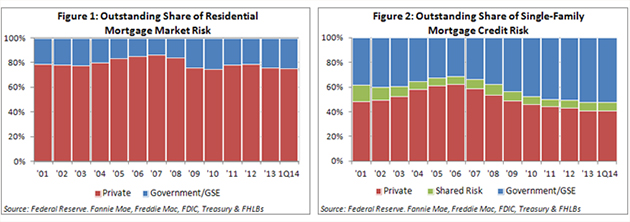The Return of Private Capital

In the wake of the housing crisis, there has been much focus on private capital1 and its role in the mortgage market, as policymakers and market experts have called for greater private capital investment in the market.
In this edition of Housing Insights, we examine the level of private capital participation in the mortgage market following the financial and housing crisis. Although we find that private market participants remain a significant source of liquidity to the U.S. mortgage market, we also find that the decline in private share of new originations has been substantial.
As of Q1 2014, private investors hold market risk2 on an estimated $8.3 trillion, or more than 75 percent, of the stock of residential mortgage debt outstanding (MDO) (Figure 1), and stand in first-loss position for credit risk3 on an estimated $4.7 trillion, or nearly 50 percent, of the stock of single-family MDO4 (Figure 2).

Those arguing for an increase in private capital investment in the mortgage market generally refer to the share of new mortgage originations for which private market participants take mortgage credit risk. Following the housing crisis, private market participants reduced investment in the flow of mortgage originations, leading to a decline in private market investment in the stock of single-family MDO. The share of mortgage originations for which private market participants stood in first credit loss position reached a low of 21 percent in 2009, but that share has since expanded to more than 30 percent in 2013. However, although private capital investment in newly originated mortgage credit risk has increased since the financial crisis, it must increase further to reverse the continuing decline in private share of credit risk on MDO.
This Housing Insights focuses on private capital investment in newly originated mortgage credit risk through:
- investment or retention of whole loans in the portfolios of financial institutions;
- investment in structured transactions or private-label securities (PLS) backed by mortgage assets; and
- credit risk sharing through Credit Risk Transfer (CRT) transactions issued by the government sponsored enterprises
Read the full Housing Insights to learn more.
1 For the purposes of this article, we adopt the common meaning of private capital investors: federal and state-chartered banks, thrifts, credit unions, insurance companies, and REITs, as well as unchartered mortgage investors (e.g., PIMCO) are included among private capital investors. Government agencies and the government sponsored enterprises (GSEs), both pre- and post-conservatorship, are not included among private capital investors. We recognize that some analysts would not consider banks that can fund mortgage investments using FDIC-insured deposits to be private investors.
2 Market risk for a mortgage investment is the risk that the market value of a mortgage asset will change in response to changes in interest rates and other factors. The holder of market risk on a mortgage loan will generally book the asset on its balance sheet.
3 Credit risk for a mortgage investment is the risk that the borrower fails to repay the loan as required.
4 Due to data limitations, we report credit risk for the single-family market and market risk for the residential market.
Gerry Flood
Director, Strategic Planning
Economic & Strategic Research
October 14, 2014
The author thanks Andrew Bon Salle, Doug Duncan, Patrick Fischetti, Tom Seidenstein and David Swift for valuable comments in the creation of this commentary. Of course, all errors and omissions remain the responsibility of the author.
Opinions, analyses, estimates, forecasts, and other views of Fannie Mae's Economic and Strategic Research (ESR) group included in this commentary should not be construed as indicating Fannie Mae's business prospects or expected results, are based on a number of assumptions, and are subject to change without notice. How this information affects Fannie Mae will depend on many factors. Although the ESR group bases its opinions, analyses, estimates, forecasts, and other views on information it considers reliable, it does not guarantee that the information provided in these materials is accurate, current, or suitable for any particular purpose. Changes in the assumptions or the information underlying these views could produce materially different results. The analyses, opinions, estimates, forecasts, and other views published by the ESR group represent the views of that group as of the date indicated and do not necessarily represent the views of Fannie Mae or its management.
